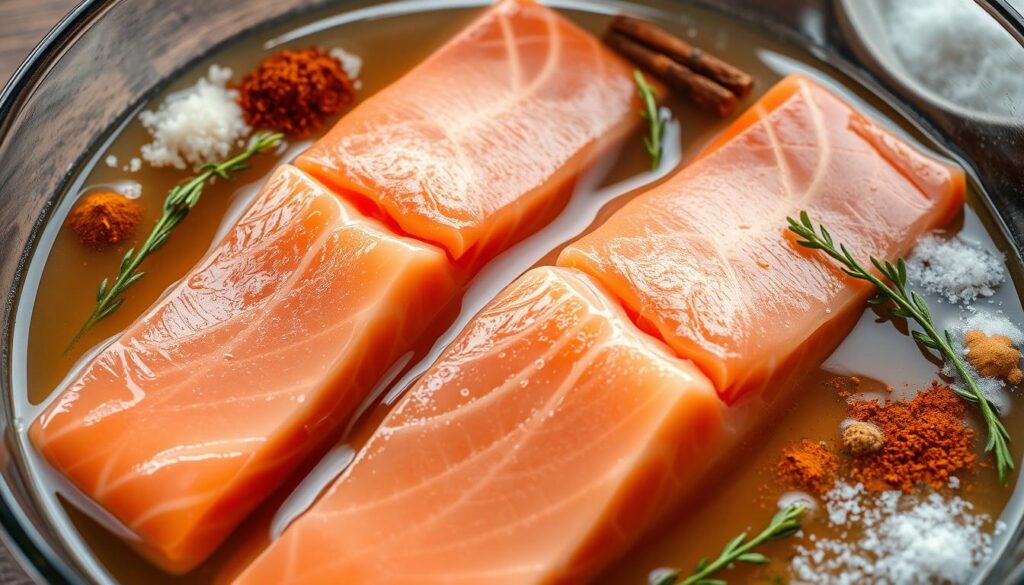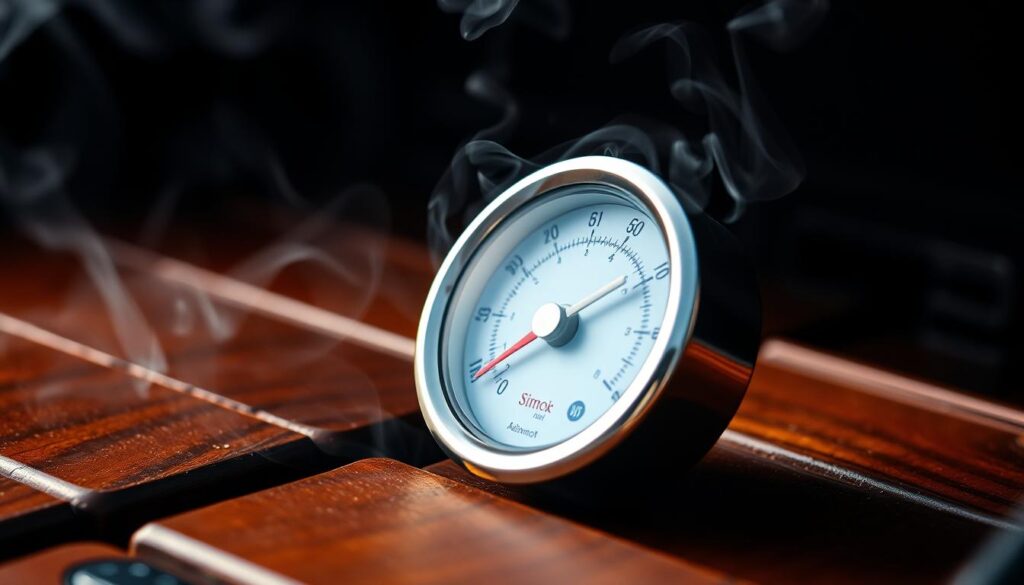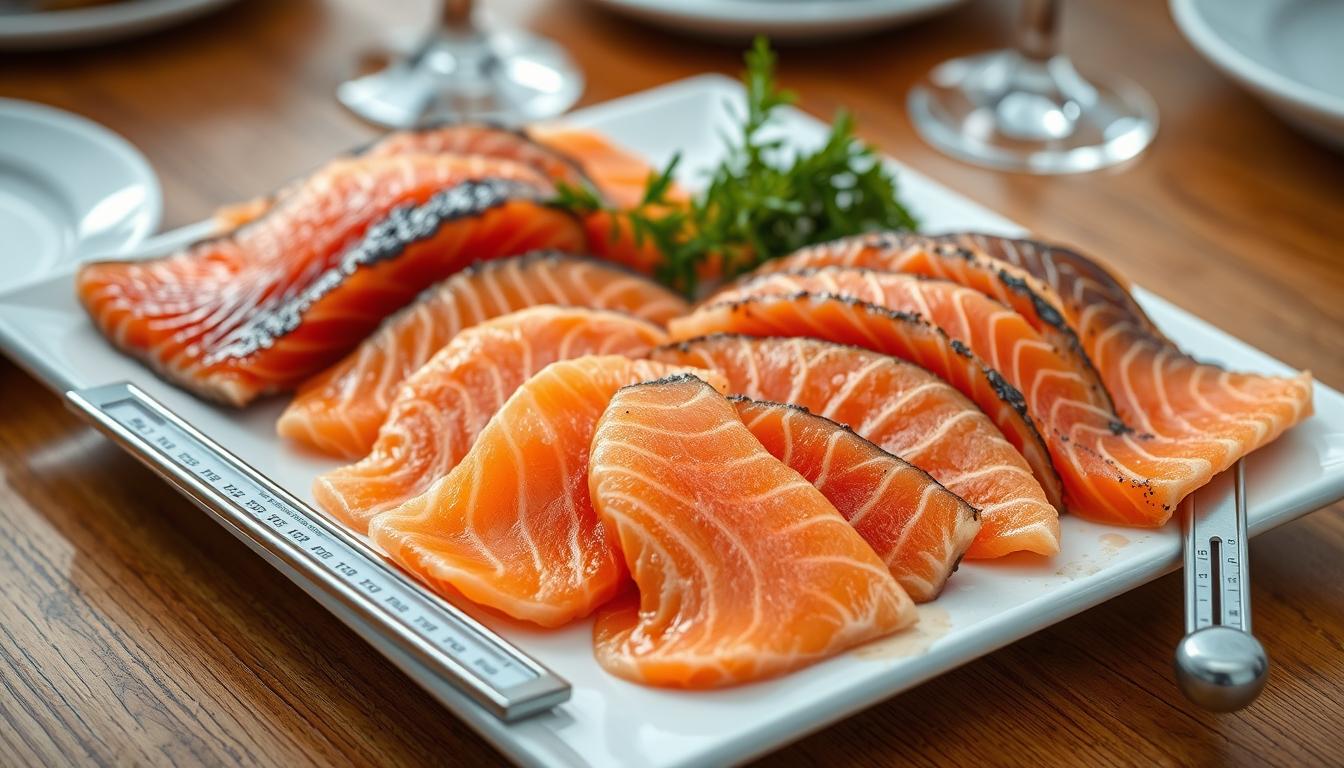The smell of smoked salmon is irresistible. It’s a favorite for special moments and cozy gatherings. But, have you thought about how temperature affects its taste and texture? Let’s explore the world of smoked salmon and learn how to control temperature for the best results.
Table of Contents
Introduction to Smoked Salmon
Smoked salmon is a favorite among food lovers everywhere. It’s made through a detailed process that focuses on temperature control. This ensures the perfect mix of taste and texture.
From the start, when the salmon is salt-cured, to the end, when it’s smoked, keeping the temperature right is key. It’s important for both food safety and getting the best results.
Significance of Temperature Control in Smoked Salmon Preparation
Temperature is very important in making smoked salmon. It helps bring out the flavor and aroma. But, it also keeps the food safe to eat.
If the temperature isn’t right, bad bacteria can grow. This can ruin the quality and safety of the smoked salmon.
Overview of Cold Smoking and Hot Smoking Methods
- Cold Smoking: This method uses temperatures below 90 degrees Fahrenheit. It gives a light, delicate smoke flavor and a fresh, soft texture.
- Hot Smoking: This process uses higher temperatures, above 120 degrees Fahrenheit. It adds a stronger smoky taste and a firmer texture to the salmon.
Knowing how these smoking methods work is key to making great smoked salmon. It helps you get the taste and texture you want.
“Smoking fish at lower temperatures, such as in cold smoking, results in less infused smoke, creating a fresher and more subtle taste.”
The Science Behind Salt Curing
Salt curing is key in making smoked salmon. It preserves the fish and adds flavor. Salt and sugar draw out moisture, stopping harmful bacteria.
Role of Salt and Sugar in Curing Salmon
Salt and sugar pull moisture from the fish, killing bacteria. Good bacteria then grow, making the fish safer and more acidic.
Formation of the Protective Pellicle
During curing, proteins form a sticky layer on the salmon’s surface. This layer, called a pellicle, keeps moisture in and helps smoke penetrate. Without it, the salmon would dry out.
“As little as one-fourth of nitrites may remain in cured meat after cooking.”
| Ingredient | Typical Concentration |
|---|---|
| Sodium Nitrate (Curing Salt) | 200 ppm or lower |
| Brine Solution | 1 cup salt per 1 gallon water |
| Salt Content in Dry-Salted Fish | 25-30% |
| Salt Content in Smoked Fish | 2-3% |
Understanding salt curing is vital for quality smoked salmon. It ensures the fish stays moist and flavorful during smoking.
Hot Smoking Process
Hot smoking salmon requires the right temperature. The best range is 150-170°F (66-77°C). This ensures the salmon is safe and tastes great.
Ideal Temperature Range for Hot Smoking
Hot-smoked salmon cooks at a higher temperature than cold-smoked. This higher heat seals in the salmon’s flavors. To get the best taste, keep the smoker at 150-170°F (66-77°C).
Monitoring Internal Temperature for Doneness
It’s important to check the salmon’s internal temperature. It should be between 120-135°F (49-57°C). This makes the salmon tender and juicy.
Use a thermometer with an air probe and a low-temperature alarm. It helps keep the salmon perfect and prevents it from drying out.
Smoked Salmon Temperature
Getting the perfect doneness for smoked salmon is all about controlling the temperature. The salmon’s internal temperature is key to its texture and taste. Let’s look at the temperature guide from raw to overcooked salmon.
Temperature Guide from Raw to Overcooked Salmon
- 70°F: The salmon is soft, slick, smooth, and translucent.
- 120°F: The flesh becomes resilient, less slick, and more fibrous, exuding juice when chewed or cut.
- 130°F: Sheets of protein begin to separate, becoming flaky, and fiber-weakening enzymes denature and become inactive.
- 140°F: Proteins continue to shrink, the texture becomes firm, fibrous, and fragile, with little free juice left.
- 150°F: The protein becomes progressively more firm, dry, flaky, and fragile.
- 160°F: The flesh is stiff and dry, and all protein fibers have denatured and coagulated.
The best temperature for fully cooked smoked salmon is 145°F on the inside, as the USDA suggests. This ensures the salmon is cooked through but still moist and tender.
“Achieving the perfect doneness for smoked salmon is all about temperature control.”
Choosing the Right Salmon
Choosing the right salmon is key for great smoked salmon. Wild-caught salmon, like coho, sockeye, or king, are top choices. They have more fat and taste better when smoked.
If you can’t find wild salmon, farmed salmon works too. But, it might taste milder and feel softer. Look for farmed salmon that’s moist and firm, without spots.
- Wild-caught salmon, such as coho, sockeye, or king, are ideal for smoking due to their higher fat content and robust flavor.
- Farmed salmon can also be used for smoking, but may have a milder flavor and more delicate texture.
- Regardless of the salmon type, look for a moist, firm fillet that is free of discoloration or spots.
Choosing the freshest, highest-quality fish is crucial. This ensures your smoked salmon tastes great and has the right texture.
“The best salmon for smoking are those with a higher fat content, such as wild-caught coho, sockeye, or king salmon. These varieties have a richer flavor that stands up well to the smoking process.”
Brining and Seasoning Salmon
Getting the perfect smoked salmon begins with brining. Brining is key to keeping moisture in and adding great flavors. By soaking the salmon in a saltwater mix, you get a silky texture and better taste.
The Wet Brining Process and Duration
To brine your salmon, mix water, kosher salt, and brown sugar. Use a 2:1 brown sugar to salt ratio. Let the salmon soak in this brine for 6-8 hours or overnight. Longer brining means more flavor.
- Prepare the brine solution with water, kosher salt, and brown sugar.
- Submerge the salmon fillets in the brine for 6-8 hours or overnight.
- The longer the brining time, the more flavorful the salmon will be.
After brining, the salmon will have a shiny, sticky layer. This is called the pellicle. It’s crucial for smoking. The pellicle keeps moisture in and helps smoke penetrate, making the salmon taste amazing.
| Ingredient | Quantity |
|---|---|
| Salmon Fillets | 2-4 lbs |
| Kosher Salt | 1/2 cup |
| Brown Sugar | 1 cup |
| Water | 1 gallon |
Remember, the secret to great smoked salmon is in the brining and seasoning. By following these steps, you’ll make a dish that rivals any restaurant.

Smoking Time and Temperature Control
To get perfect smoked salmon, you need to control the smoking time and temperature well. The cooking time for smoked salmon changes based on the fillet size, thickness, smoker type, and desired doneness. Generally, a 2-3 lb salmon fillet takes 1-3 hours to smoke at 150-170°F.
The real sign of doneness is the salmon’s internal temperature, not just the time. The FDA says to cook salmon to 145°F. For a moist and tender texture, remove the salmon when it reaches 130-135°F. The temperature will rise a bit more during the resting time.
| Smoking Method | Temperature Range | Smoking Duration |
|---|---|---|
| Cold Smoking | 80°F | 12-24 hours |
| Hot Smoking | 120-180°F | 2-3 hours |
The smoking temperature and time also affect the salmon’s pellicle. A good pellicle keeps moisture in and prevents drying out.
Keeping the temperature steady is key for the right texture and flavor. Use a thermometer, like the Typhur Sync Meat Thermometer, to check the smoker and salmon temperatures. This ensures your smoked salmon turns out great.
Monitoring Smoker Temperature
Keeping the smoker temperature just right is key for delicious smoked salmon. You need a thermometer with an air probe and a low alarm. This ensures the temperature stays between 150-170°F, perfect for hot smoking salmon.
The ThermaQ is a top pick for a thermometer. It has two channels to watch both the smoker and meat temperatures. Its accuracy and alarms help you keep the salmon from getting too hot.
Recommended Smoker Thermometer
Watching both the smoker and salmon temperatures closely is crucial. A good thermometer like the ThermaQ helps keep the smoker temperature just right. This way, you get amazing results every time.
| Thermometer | Features | Price |
|---|---|---|
| ThermaQ |
| $99.99 |
Choosing a quality thermometer like the ThermaQ means your smoked salmon will always be perfect. It will be moist and full of flavor.

Serving and Storing Smoked Salmon
Smoked salmon is a delicious delicacy that’s great in many dishes. It’s perfect for brunch, salads, or fancy appetizers. It adds a touch of class to any meal.
To serve smoked salmon, pair it with bagels, cream cheese, capers, and red onions. You can also add it to salads, pasta, pizza, dips, and sandwiches. For a special touch, try it on blini or avocado toast.
When storing leftover smoked salmon, wrap it tightly in plastic wrap or use an airtight container. Keep it in the fridge for up to 4 days. For longer storage, freeze it for up to 3 months. To reheat, warm it gently over low heat to keep it moist.
Remember, proper storage and handling of smoked salmon is key for food safety and enjoyment.
“Smoked salmon is a culinary treasure that elevates any dish, from breakfast to dinner. Its versatility and rich flavor make it a must-have in any well-stocked kitchen.”
Troubleshooting Common Issues
Ever cooked fish and seen a white, chalky stuff on top? That’s albumin, a harmless, tasteless liquid protein. It forms and escapes to the surface when cooking. You’ll see it more on salmon because of its white and pink colors.
To avoid albumin on your smoked salmon, follow a few steps. First, wet brine the salmon before smoking. This creates a protective layer on the fish. Also, cook at a low and slow temperature, between 150-170°F. This keeps albumin from escaping.
If albumin still appears, just scrape it off. It won’t ruin the taste or quality of your smoked salmon. By controlling the temperature and wet brining, you can make your smoked salmon look great every time.
FAQ
What are the key temperatures and tips for making successful homemade smoked salmon?
How does the salt cure process work to preserve the salmon?
What is the ideal temperature range for hot smoking salmon and how do you monitor doneness?
How do the different salmon temperatures affect the texture and doneness of the final product?
What are the best salmon varieties to use for smoking?
How long should you brine the salmon before smoking?
How do you monitor the smoker temperature to ensure it stays in the ideal range?
How should you store leftover smoked salmon?
What causes the white, chalky substance (albumin) on smoked salmon and how can you prevent it?
Source Links
- Smoked Salmon Temperature Guide – https://www.wowrecipez.com/smoked-salmon-temperature/
- What’s the Ideal Temperature of Cooked Salmon? | Cook’s Illustrated – https://www.americastestkitchen.com/cooksillustrated/how_tos/9999-ideal-doneness-temperature-for-wild-salmon
- Simple Smoked Salmon – https://saltpepperskillet.com/smoked-salmon/
- Cherry Smoked Salmon With Brussels Sprouts – Learn to Smoke Meat with Jeff Phillips – https://www.smoking-meat.com/cherry-smoked-salmon-with-brussels-sprouts
- How to Smoke Salmon at Home – https://explore.typhur.com/smoked-salmon
- CIA Technique of the Quarter: The Smoking Process – https://www.ciachef.edu/wp-content/uploads/2024/07/the-smoking-process.pdf
- Easy Homemade Smoked Salmon – https://www.osharak.com/easy-homemade-smoked-salmon/
- Pellet Grill Smoked Salmon – Perry’s Plate – https://www.perrysplate.com/2021/12/smoked-salmon.html
- How to Smoke Salmon – Southcentral Foundation – https://www.southcentralfoundation.com/how-to-smoke-salmon/
- How to Store, Serve and Eat Smoked Salmon – https://www.gourmetfoodstore.com/storingserving-smoked-salmon-15156
- How long does smoked salmon last? Everything you need to know + pics! – https://www.atablefullofjoy.com/how-long-does-smoked-salmon-last/
- Smoked Salmon Internal Temp: Perfect Every Time – https://www.meatrecipes.net/smoked-salmon-internal-temp/
- Smoked Salmon Internal Temperature: 11 Perfect Results – https://quickfitrecipe.com/smoked-salmon-internal-temperature/
- Is Smoked Salmon Healthy? Here’s What a Dietitian Says – https://www.eatingwell.com/article/7892708/is-smoked-salmon-healthy/

